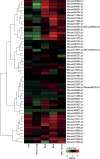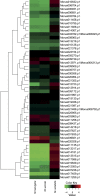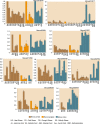Genome-wide Identification and Structural, Functional and Evolutionary Analysis of WRKY Components of Mulberry
- PMID: 27477686
- PMCID: PMC4967854
- DOI: 10.1038/srep30794
Genome-wide Identification and Structural, Functional and Evolutionary Analysis of WRKY Components of Mulberry
Abstract
Mulberry is known to be sensitive to several biotic and abiotic stresses, which in turn have a direct impact on the yield of silk, because it is the sole food source for the silk worm. WRKYs are a family of transcription factors, which play an important role in combating various biotic and abiotic stresses. In this study, we identified 54 genes with conserved WRKY motifs in the Morus notabilis genome. Motif searches coupled with a phylogenetic analysis revealed seven sub-groups as well as the absence of members of Group Ib in mulberry. Analyses of the 2K upstream region in addition to a gene ontology terms enrichment analysis revealed putative functions of mulberry WRKYs under biotic and abiotic stresses. An RNA-seq-based analysis showed that several of the identified WRKYs have shown preferential expression in the leaf, bark, root, male flower, and winter bud of M. notabilis. Finally, expression analysis by qPCR under different stress and hormone treatments revealed genotype-specific responses. Taken together, our results briefs about the genome-wide identification of WRKYs as well as their differential response to stresses and hormones. Importantly, these data can also be utilized to identify potential molecular targets for conferring tolerance to various stresses in mulberry.
Figures






Similar articles
-
Genome-wide analysis, expression dynamics and varietal comparison of NAC gene family at various developmental stages in Morus notabilis.Mol Genet Genomics. 2016 Jun;291(3):1305-17. doi: 10.1007/s00438-016-1186-z. Epub 2016 Mar 4. Mol Genet Genomics. 2016. PMID: 26942603
-
Genome-wide analysis of the WRKY gene family in the cucumber genome and transcriptome-wide identification of WRKY transcription factors that respond to biotic and abiotic stresses.BMC Plant Biol. 2020 Sep 25;20(1):443. doi: 10.1186/s12870-020-02625-8. BMC Plant Biol. 2020. PMID: 32977756 Free PMC article.
-
Identification of WRKY Gene Family from Dimocarpus longan and Its Expression Analysis during Flower Induction and Abiotic Stress Responses.Int J Mol Sci. 2018 Jul 25;19(8):2169. doi: 10.3390/ijms19082169. Int J Mol Sci. 2018. PMID: 30044387 Free PMC article.
-
Mulberry (Morus spp.) has the features to treat as a potential perennial model system.Plant Signal Behav. 2018;13(8):e1491267. doi: 10.1080/15592324.2018.1491267. Epub 2018 Jul 26. Plant Signal Behav. 2018. PMID: 30047827 Free PMC article. Review.
-
The advent of genomics in mulberry and perspectives for productivity enhancement.Plant Cell Rep. 2011 May;30(5):825-38. doi: 10.1007/s00299-011-1059-1. Epub 2011 Mar 23. Plant Cell Rep. 2011. PMID: 21431349 Review.
Cited by
-
WRKY transcription factors and plant defense responses: latest discoveries and future prospects.Plant Cell Rep. 2021 Jul;40(7):1071-1085. doi: 10.1007/s00299-021-02691-8. Epub 2021 Apr 15. Plant Cell Rep. 2021. PMID: 33860345 Review.
-
A salicylic acid inducible mulberry WRKY transcription factor, MiWRKY53 is involved in plant defence response.Plant Cell Rep. 2021 Nov;40(11):2151-2171. doi: 10.1007/s00299-021-02710-8. Epub 2021 May 17. Plant Cell Rep. 2021. PMID: 33997916
-
Ectopic Expression of JcWRKY Transcription Factor Confers Salinity Tolerance via Salicylic Acid Signaling.Front Plant Sci. 2016 Oct 17;7:1541. doi: 10.3389/fpls.2016.01541. eCollection 2016. Front Plant Sci. 2016. PMID: 27799936 Free PMC article.
-
Selection of suitable reference genes for quantitative real-time PCR gene expression analysis in Mulberry (Morus alba L.) under different abiotic stresses.Mol Biol Rep. 2019 Apr;46(2):1809-1817. doi: 10.1007/s11033-019-04631-y. Epub 2019 Jan 29. Mol Biol Rep. 2019. PMID: 30694457
-
Comparative transcriptomics of leaves of five mulberry accessions and cataloguing structural and expression variants for future prospects.PLoS One. 2021 Jul 14;16(7):e0252246. doi: 10.1371/journal.pone.0252246. eCollection 2021. PLoS One. 2021. PMID: 34260613 Free PMC article.
References
-
- Eulgem T., Rushton P. J., Robatzek S. & Somssich I. E. The WRKY superfamily of plant transcription factors. Trends Plant Sci. 5, 199–206 (2000). - PubMed
-
- Ross C. A., Liu Y. & Shen Q. J. The WRKY Gene Family in Rice (Oryza sativa). J. Integr. Plant Biol. 49, 827–842 (2007).
-
- Ulker B. & Somssich I. E. WRKY transcription factors: from DNA binding towards biological function. Curr. Opin. Plant Biol. 7, 491–498 (2004). - PubMed
Publication types
MeSH terms
Substances
LinkOut - more resources
Full Text Sources
Other Literature Sources

